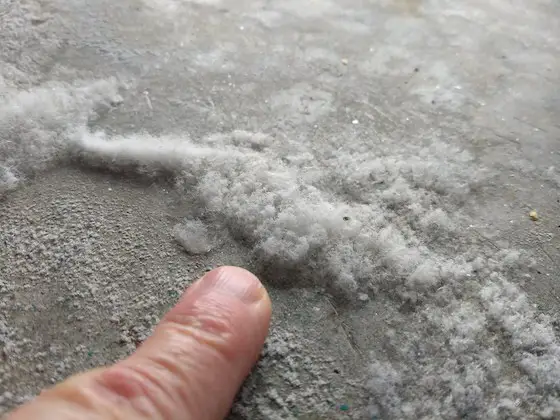White Fluffy Mold on Concrete

You're looking at salt, not mold. My finger is pointing to efflorescence on a concrete garage floor. These are harmless rock salt crystals not mold as many believe it to be. Copyright 2022 Tim Carter
White Fluffy Mold on Concrete - It's Salt
Not too many years ago I recorded a video in my garage as spring debuted. You can watch this video for free on right here on my website.
This video gets comments each and every week from folks like you. Most of the comments surprise me because the viewer is relieved to discover the fluffy white deposits on their concrete floors, brick walls, or basement walls is harmless salt, not deadly mold.
High School Chemistry - Salt Dissolves in Water
I routinely fall into the trap thinking that you might know all about efflorescence and the truth is many don’t understand it at all. I remember doing an experiment in high school chemistry class that demonstrated the mechanics of what causes this white powder to appear and how to get rid of it.
In my case, rock salt is used on the roads in central New Hampshire during ice and snow storms. The rock salt, once it comes into contact with the ice or snow, dissolves and turns the frozen precipitation into a salty liquid brine. This salt-water brine then drips off my car when I park it in my garage.
The brine soaks into the concrete floor. With the garage temperature close to freezing and there’s no wind in the garage, the evaporation of the water in the concrete happens very slowly. And each time I drive back into the garage, I add more liquid brine into the concrete.
Brine Comes to Surface and Poof!
When spring arrives with warmer temperatures, the brine starts to come to the surface of the concrete like the hosta shoots that peak up from the soil next to our front sidewalk. The first place the efflorescence appears is along the tiny hairline cracks where the salt brine entered the concrete with ease. Soon patches of fluffy white crystals surround the parking area of the car.
I can see why you might think these harmless salt deposits are some sort of scary mold. They do look strange and they can appear in a short amount of time. But you might make a big mistake trying to get rid of them.
How NOT to Get Rid of the Salt
You get out your hose and try to wash the deposits away. This just dissolves the salt again and allows it to soak back into the concrete to only appear again in a few days when the brine comes back to the surface of the concrete.
Best Way to Remove the Salt Deposits
The best way to get rid of efflorescence is to just brush the salt off the concrete or brick and blow it away. You may need to use a stiff scrub brush in some instances. Never use a steel wire brush as that will harm any masonry surface, including concrete.
The salt deposits can and do happen in places that don’t get snow and ice. Many soils and sand deposits contain the invisible salts that can create efflorescence. The salt can be an ingredient in concrete paving brick you may use for a patio. The salt can be part of the sand used to make brick mortar.
Salt on Retaining Walls
The salt can be in soil behind a retaining wall. In all these cases, when water enters the masonry surface, it dissolves the salt just like you might have done that day in your high school chemistry lab. Now you have the brine in the masonry. Wind and warmth pull this liquid to the surface where the water in the brine evaporates leaving the salt behind.
Hard Water Deposits
This is the exact same process with normal hard-water deposits you might see in your kitchen or bathroom. The salts are already dissolved in your drinking water. When this water gets on a dark countertop, or the bright metal finish of a faucet, you can see the white salts in a few hours after the water droplets evaporate.
You can often buff the surface with an old towel and remove them. If allowed to accumulate on a shower door, faucet, or counter, you can remove them with ease using a paper towel saturated with white vinegar. Vinegar is a mild acid and it can dissolve light amounts of hard-water deposits with ease if you’re patient.
Go here to see dramatic before and after photos of how vinegar removed thick hard-water deposits. SCROLL to the bottom of the page to see the photos of the tile around the fountain.
Don’t rub the deposits with the paper towel. Just drape the saturated towel over the area that has the deposits and walk away. Let the vinegar work on its own for a few hours. In almost all cases when you come back and rub the surface with the paper towel, rinse with clear water, and dry with a clean rag, the deposits will be gone.
Beware Vinegar on Marble
Don’t use the vinegar on polished or burnished marble surfaces. Or, if you do, test it with a small drop applied with a cotton swab. Put one single drop of vinegar on the marble and come back in a few hours.
You want to see if the vinegar alters the polish of the marble. You may not realize it, but the marble has a very similar chemical makeup as the salt, Strong acids will etch marble. It’s just a matter if the low-grade vinegar acid will harm your marble.
Column 1465
2 Responses to White Fluffy Mold on Concrete